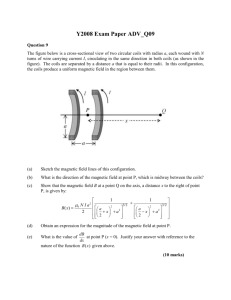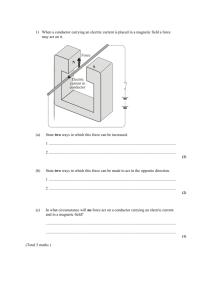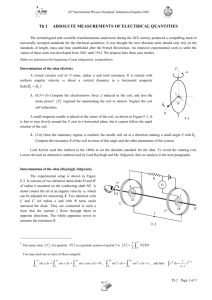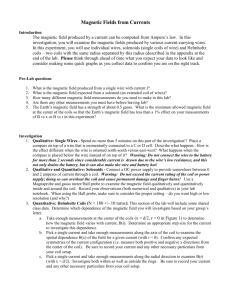NMR-5
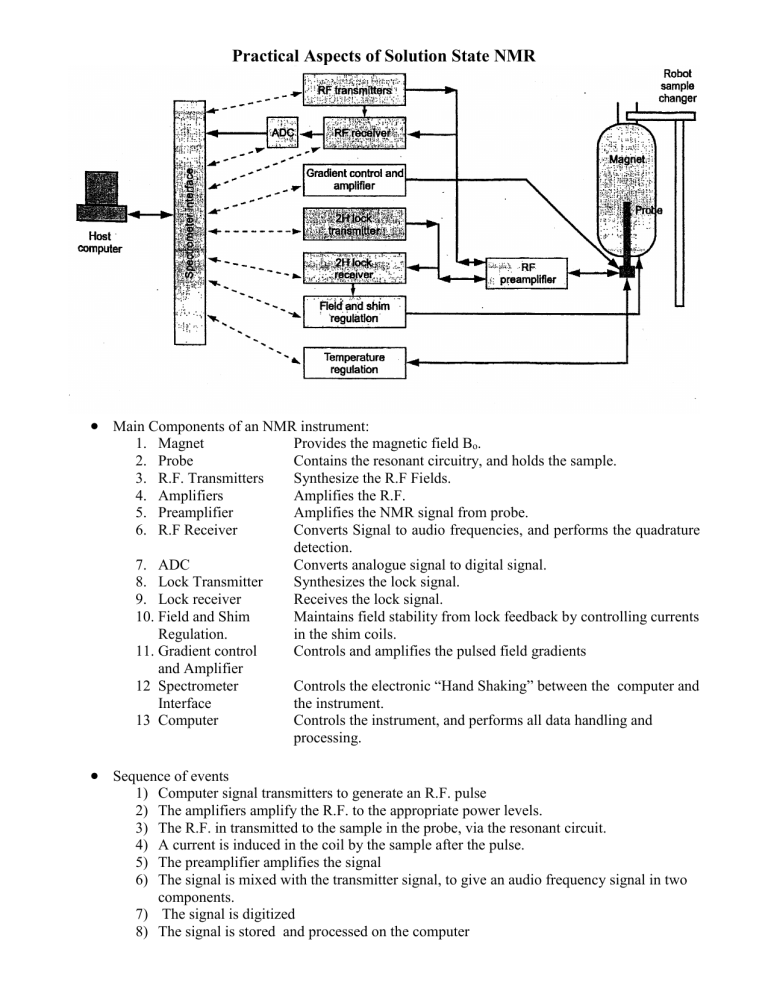
Practical Aspects of Solution State NMR
Main Components of an NMR instrument:
1.
Magnet Provides the magnetic field B o
.
2.
Probe
5.
Preamplifier
Contains the resonant circuitry, and holds the sample.
3.
R.F. Transmitters Synthesize the R.F Fields.
4.
Amplifiers Amplifies the R.F.
Amplifies the NMR signal from probe.
6. R.F Receiver Converts Signal to audio frequencies, and performs the quadrature detection.
Converts analogue signal to digital signal. 7. ADC
8. Lock Transmitter Synthesizes the lock signal.
9. Lock receiver Receives the lock signal.
10.
Field and Shim Maintains field stability from lock feedback by controlling currents
Regulation.
11. Gradient control
and Amplifier
12 Spectrometer
Interface
13 Computer in the shim coils.
Controls and amplifies the pulsed field gradients
Controls the electronic “Hand Shaking” between the computer and the instrument.
Controls the instrument, and performs all data handling and processing.
Sequence of events
1) Computer signal transmitters to generate an R.F. pulse
2) The amplifiers amplify the R.F. to the appropriate power levels.
3) The R.F. in transmitted to the sample in the probe, via the resonant circuit.
4) A current is induced in the coil by the sample after the pulse.
5) The preamplifier amplifies the signal
6) The signal is mixed with the transmitter signal, to give an audio frequency signal in two components.
7) The signal is digitized
8) The signal is stored and processed on the computer
The Magnet
Modern spectrometers employ super-conducting solenoid coils to provide the magnetic field.
Super-conducting magnets provide a permanent stable field, up to 21 T. Electromagnets would have to consume massive amounts of electrical energy in order to achieve the same field. (in
Tallahassee Florida there is such a magnet which required a committed nuclear reactor to provide the power).
The coils are wound with wire composed of a niobium alloy, ie niobium tin. This coil is placed in a dewar containing liquid Helium, thus keeping the system at 4 K, which is required take make the wire super-conducting. This dewar in turn is kept in a dewar filled with liquid nitrogen, keeping the system at 77 K. This is done to minimize helium boil-off, which since helium is expensive to replace. The whole assembly is then encased in an evacuated container, minimizing thermal contact with the environment.
Cross Section of a Super-conducting Magnet
Shim Coils Bore Sample
Sample Holder
(Spinner)
Solenoid
Dewar filled with N
2
(l)
Coil Evacuated
Dewar filled
Container
Probe with He(l)
The magnet bore is open to the outside environment and hence is at ambient temperature. It contains the shim assembly, which are a set of coils through which current is passed, generating magnetic fields used to make adjustment to the applied field.
Each coil is wound in a unique geometry as to generate magnetic field, which are orthogonal to each other. This allows one to make small adjustment to the homogeneity of the magnetic field.
The magnetic field has to be as homogeneous over the entire sample to ensure optimum resolution. In fact, the magnetic field can be so accurately controlled that it is possible to obtain linewidths of the order of 0.1 Hz. For a magnet that operates at 500 MHz, this implies accuracy of up to 0.2 parts per billion.
Question:
Why must the sample be placed near the magnetic center of the magnet?
The Probe
The probe holds the sample in place, in the coil, at the center of the magnetic field. The sample is spun at around 20 Hz in order to average out the effect of small field inhomogeneities in the transverse plane.
The Probe contains the resonant circuit, which is composed of a coil and several variable capacitors. These capacitors can be adjusted in order to tune the circuit to the desired frequencies.
A probe used for Solution NMR
.
These circuits are designed to be resonant at several frequencies at once. Often an additional coils to provide simultaneous R.F irradiation to additional nuclei.
The probe also contains the gradient coils, used to apply pulsed field gradients.
The probe is also tuned to deuterium, which is used as a reference signal to adjust the magnetic filed in real time. This is known as the “lock”.
There are typically two types of circuits:
1) Tunable over a wide frequency range, which is referred to as wide band.
2) Tunable to a small frequency range, which is referred to as narrow band.
Question :
Sometimes probes have an additional outer coil. Why would it not be used for detection?
The solvent
Solvent used in NMR are dueterated, ie where all the hydrogen are replace by deuterium. This is done to avoid an otherwise very large solvent background signal, which would severely challenge the dynamic range of the ADC but will also overlap with signal of interest.
The signal from the deuterium is used as in internal frequency standard, to adjust the magnetic field in real time, this is known as the frequency lock .
The choice of solvent will have to take accommodate the following concerns:
1.
Does the residual proton signal overlap with peaks of interest?
2.
Does the carbon signal interfere with carbon signal of interest?
3.
Does the residual water signal interfere?
4.
Does it dissolve enough of the sample to give adequate signal?
5.
Is it a non-viscous liquid in the temperature range of interest?
Properties of the common dueterated solvents.
In the past is was common to add a reference compound to the sample, such as TMS, for 1 H and
13
C spectra. These days the residual proton signal from the solvent tends to be used.
Question:
a) If you had a substituted aromatic compound, that is polar which solvent would you use? b) If you had a dynamic molecule at ambient temperature which is polar, which solvent would you use in a variable temperature study.
Compounds used as internal frequency standards for various nuclei. Reference frequencies given in absolute frequencies in MHz.
Sample Preparation
Recall than the sample is place in 3, 5 or 10 mm tube in the coil.
To ensure that we obtain maximum signal, the sample must cover all of the coil volume. The liquid level must extend above the end of the coil to avoid field gradient caused by the magnetic susceptibility change at the solution air interface.
The sample must no extend beyond magnetically homogeneous region in the magnet, to ensure optimum resolution.
The sample must not extend beyond the temperature controlled region of the probe to avoid convection currents caused by temperature gradients.
Sample must be composed to pure liquid, no particulate matter should be in the tube. Suspended particles will cause resolution problems due to magnetic field gradients caused by the difference in magnetic susceptibility between the solid and liquid.. These particle can be easily removed by filtration through glass wool.
Performing a 1D NMR spectrum
1) Sample is placed in the probe, and allowed to stabilize at a preset temperature.
2) The probe is tuned to the desired frequency. This is achieved by adjusting the tuning and matching capacitors whilst monitory the reflect power from a continuous pulse train that is being applied. When the reflected power is a minimum at the desired frequency it is said to be tunes.
Reflected power as a Function of Frequency a) not tuned, b) tuned
3) The sample is locked. The deuterium channels is adjusted until signal from the solvent is found.
This channel is made to pursue the deuterium frequency as the magnetic field of the magnet drifts. The signal is detected in the dispersion mode, which has a very steep profile on resonance, thus being very sensitive the any changes in frequency and hence magnetic field.
The deuterium Lock Signal
4) The sample is shimmed. That means that the field homogeneity is optimized by adjusting current in the shim coils, which provide magnetic fields meant to cancel out any inhomogeneities over the active sample volume. The intensity of the lock signal is a measure of field homogeneity and is used as a guide when adjustments are made to the shims. Another way to monitor field homogeneity is to observe the FID of a single line.
Distortions in the ideal lineshape caused by field gradients by the shimming coils of various geometries indicated.
5) The data acquisition can proceed, and the FID is collected
a) SW - Ensure all signals of interest are within the spectral region observed .
b) NP - Ensure that enough point are collected to fully sample each line in the spectrum. i.e. that the digital resolution is sufficient to show all the information available.
c) PW - should be calibrated to 90
0
, or set to a small value for samples with long T
1
’s.
d) RG - avoid saturated the receiver, i.e. clipping the FID.
e) NS - collect enough scans to to complete any phase cylces, usually multiples of 4 or 8, and such that you have sufficient signal to noise.
6) The FID is processed: (Covered in LAB)
a) FT with LB and GB b) Phased c) Baseline corrected d) Integrated e) Printed


